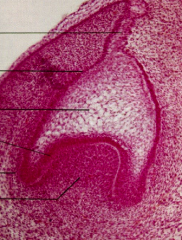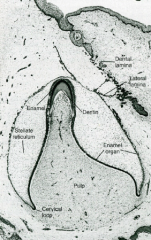![]()
![]()
![]()
Use LEFT and RIGHT arrow keys to navigate between flashcards;
Use UP and DOWN arrow keys to flip the card;
H to show hint;
A reads text to speech;
32 Cards in this Set
- Front
- Back
|
Describe enamel |
Hard tissue covering of the tooth crown and hardest of all the biological tissues |
|
|
Enamel is derived from ________? |
Ectoderm |
|
|
Enamel is made up of? |
Enamel is highly mineralised (inorganic) content - made up of hydroxyapatite (calcium + phosphate) crystal units (prisms and rods) |
|
|
What is the specialised enamel-making cells? |
Ameoloblasts |
|
|
What is calcium hydroxyapatite and what is its unit cell formula? |
It is a carbonated biological apatite (impure) Unit cell formula: Ca10 (PO4)6 (OH)2 |
|
|
Ground section of enamel and dentine |

|
|
|
What is the origin of the enamel protein? |
Ectodermal |
|
|
What is amelogenin and what does it do? |
Major protein constituent of the developing enamel matrix. Needed for rods. |
|
|
What is ameloblastin and what does it do? |
A minor protein of the enamel matrix. It is for attachment to dentine. |
|
|
What are enamelins and their function? |
It is a enamel-specific proteins, which have high affinity for binding hydroxyapatite crystals. |
|
|
Enamel matrix is formed from___? Dentine originates from the ________ ________? |
Enamel matrix = enamel organ Dentine = dental papilla |
|
|
What develops from dental follicle? |
Cementum and periodontal ligament |
|

Identify what stage |

|
|

Identify what stage |

|
|

Identify the different types of cells develop in enamel organ |

|
|
|
What are the four components of enamel organ? |
1. Outer enamel epithelium (OEE) 2. Stellate reticulum (SR) 3. Inner enamel epithelium (IEE) 4. Stratum Intermedium (SI) |
|
|
Describe stellate reticulum |
Centre of the enamel organ - rich in glycosaminoglycans (hydrophilic) |
|
|
Describe OEE |
cuboidal cells on the periphery of the enamel organ |
|
|
Describe IEE |
short columnar cells that will eventually become ameloblasts |
|
|
Describe Stratum Intermedium |
derived from SR and IEE - rich in the enzyme alkaline phosphate |
|

Identify what stage |

Bell stage |
|
|
Enumerate the enamel production |
1. Morphogenic ("preparatory") 2. Histodifferentiation 3. Initial secretory (no Tomes) 4. Secretory (+ Tomes) 5. Ruffled-ended ameloblast 6. Smooth-ended ameloblast 7. Protective stage ("end of life") |
|
|
Types of enamel forms: |
First-formed enamel - prismless Bulk of tissue with prisms Last-formed enamel - prismless |
|
|
What are the enzymes involve in extracellular processing and degradation of enamel proteins? |
Enamelysin Kallikrein4 (KLK4) |
|
|
What are the enzymes involve in bone resorption (bone remodeling)? |
MMP-9 and cyteine proteases |
|
|
What are the enamel-related disorders? |
1. Amelogenesis imperfecta - cause: malfunctioning enamel matrix proteins 2. Fluorosis 3. Molar incisor hypomineralisation (MIH) - cause: trauma? |
|
|
What is the composition of mature human enamel? |
Inorganic (mineral) - weight: 95%, volume: 86% Organic (protein) - weight: 1%, volume: 2% Water - weight: 4%, volume: 12% |
|
|
What is the shape of calcium hydroxyapatite in enamel? |
Hexagonal crystals |
|
|
What are rods? |
Millions of carbonated hydroxyapatite are arranged in long, thin structures called rods. |
|
|
What are inter rod? |
Area between the rods. PS: same crystal composition, different crystal orientation |
|
|
Describe appositional stage for enamel |
1. Fomration of dental hard tissues 2. Transition from the synthesis of soft tissue to hard tissue formation (enamel matrix formed form the enamel organ [IEE + SI + SR + OEE]) (dentine originates from dental papilla) |
|
|
Name 6 other structures that can be found in the enamel.
|
Striae of Retzius - enamel “growth rings” Cross striations – cross-bands every 4 mm - circadian pattern of rod formation Hunter-Schreger bands – optical phenomena Enamel tufts – directional changes in rod groups Enamel lamella – cracks in the enamel Enamel spindles – “invasion” by odontoblasts |

